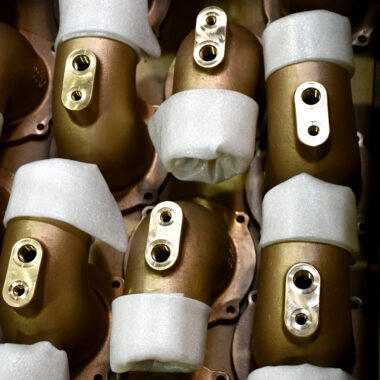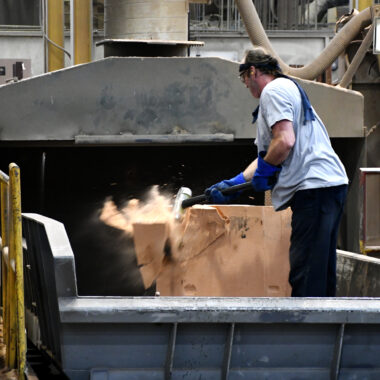Grasping About Aluminum Casting: Methods Debunked
Grasping About Aluminum Casting: Methods Debunked
Blog Article
From Layout to End Up: The Full Aluminum Spreading Process Demystified
In the world of manufacturing, the procedure of aluminum spreading stands as a crucial method that has fueled industries for decades. Keep tuned as we study the complete aluminum casting process, revealing the ins and outs that change raw materials into polished items.
Creating the Casting Mold And Mildew
When starting the aluminum spreading procedure, precise attention to developing the casting mold and mildew is paramount for making sure the final item's integrity and quality. The spreading mold and mildew works as the foundation for the whole casting process, dictating the shape, dimensions, and surface finish of the ultimate aluminum component.
To develop an efficient casting mold, engineers need to consider different elements such as the complexity of the component, the kind of light weight aluminum alloy being made use of, and the desired residential properties of the final item. about aluminum casting. Computer-aided layout (CAD) software program is commonly employed to develop comprehensive schematics of the mold and mildew, permitting precise modification and optimization
Furthermore, the design of the casting mold straight affects the performance and cost-effectiveness of the casting procedure. A properly designed mold decreases material waste, reduces the need for substantial post-casting machining, and boosts overall manufacturing speed.
Melting and Pouring Aluminum
With the layout of the casting mold finalized, the next vital action in the light weight aluminum spreading process is the melting and pouring of the light weight aluminum alloy. The procedure starts with loading the aluminum alloy into a furnace where it is heated up to its melting point, generally around 660 ° C(1220 ° F) for light weight aluminum. Crucible furnaces, induction heaters, or gas-fired reverberatory furnaces are typically utilized for melting light weight aluminum. As soon as the light weight aluminum is liquified, it is essential to maintain the temperature within a particular array to make sure the top quality of the castings.
The liquified light weight aluminum is carefully transferred from the heating system to the spreading mold and mildew. Proper pouring methods contribute dramatically to the total high quality of the final aluminum casting.
Cooling and solidifying Process
Upon completion of the putting procedure, the molten light weight aluminum changes into the solidifying and cooling stage, a vital stage in the light weight aluminum casting process that directly impacts the last item's stability and features. As the light weight aluminum begins to cool, its particles prepare themselves right into a solid kind, gradually taking on the shape of the mold.
During this stage, it is important to control the cooling process meticulously to prevent problems such as porosity, shrinkage, or inner stresses. Various cooling methods, such as air cooling, water quenching, or regulated air conditioning chambers, can be employed based on the specific demands of the casting (about aluminum casting). By keeping track of and regulating the solidification and cooling down procedure, manufacturers can guarantee the manufacturing of top quality light weight aluminum castings with the desired mechanical and metallurgical residential or commercial properties

Getting Rid Of the Final Casting
As soon as the aluminum spreading has actually completely strengthened and cooled down in the mold, the following action in the process entails carefully removing the final spreading. This action is vital to ensure that the light weight aluminum part is effectively drawn out with no damages or defects.
To get rid of the spreading, the mold and mildew is opened up, and the casting is extracted utilizing various techniques depending upon the intricacy of the part and the mold layout. For less complex forms, the casting can usually be conveniently eliminated by hand or with straightforward tools. For even more detailed styles, added tools such as ejector pins, air blasts, or hydraulic systems may be needed to facilitate the removal process without triggering any harm to the spreading.
After the spreading is effectively eliminated from the mold, any excess product such as gateways, runners, or risers that were used throughout the spreading process are trimmed off. This action assists in accomplishing the final wanted form of the aluminum part prior to it goes through any added completing processes.
Finishing and Top Quality Examination
The last stage in the light weight aluminum casting process entails careful finishing strategies and rigorous quality examination protocols to make certain the integrity and accuracy of the cast aluminum components. Finishing strategies such as grinding, sanding, and shot blasting are made use of to advice eliminate any excess product, smooth harsh surface areas, and enhance the visual appeal of the last product. These procedures not only enhance the appearance however also make sure that the parts satisfy the specified dimensional tolerances and surface area finish needs.

Verdict
Finally, the aluminum spreading process involves making the mold, melting and pouring light weight aluminum, solidifying and cooling the spreading, removing the last product, and completed with a high quality evaluation. Each action is vital in making certain the end product meets the wanted requirements. By recognizing the entire process, producers can produce high-quality aluminum spreadings efficiently and successfully.
Stay tuned as we dissect the complete aluminum spreading process, revealing the ins and outs that change raw materials into polished products.
With the design of the spreading mold wrapped up, the following essential action in the aluminum casting process is the melting and putting of the light weight aluminum alloy.Upon completion of the putting process, the molten aluminum transitions right into the strengthening and cooling down phase, an essential phase in the aluminum casting procedure that directly affects the last item's integrity and attributes.The last phase in the aluminum casting process includes careful ending up techniques and rigorous high quality assessment methods to make certain the integrity and precision of the cast aluminum parts.In final thought, the aluminum casting process includes developing the mold, melting and putting aluminum, strengthening and cooling the casting, removing the final product, and completing with a high why not try this out quality assessment.
Report this page